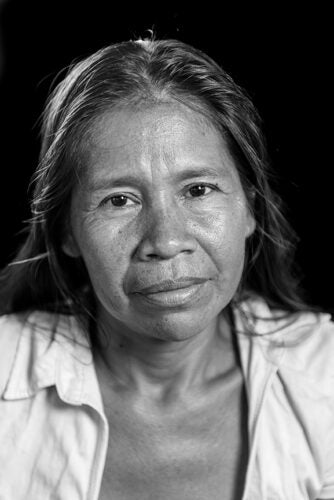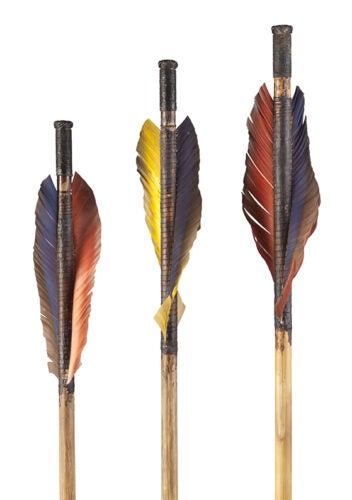
The Ese’Eja People of the Amazon: Connected by a Thread, will open Oct. 18 at the Ron and Linda Yanke Research Center gallery. It will give visitors an intimate look at the lives of one of the last indigenous tribes in the Amazon basin of Peru through an array of elegant silver-toned photographs, objects, drawings, text and video.
It will give students in art professor Stephanie Bacon’s course on exhibition design something more – the chance to install an entire exhibition, one that comes to Boise State all the way from the Smithsonian National Museum of the American Indian and the Peruvian Embassy in Washington, D.C.
Connected by a Thread represents a departure from traditional ethnographic exhibitions, said Bacon. Those are often curated from an outside, academic perspective in which objects are “on display” without any ties to their original context. In this case, the Ese’Eja (EH-see-AY-ha) people worked alongside project team leaders and photographers – Jon Cox from the University of Delaware and Andrew Bale from Dickinson College – to create the exhibition, select its treasures and write interpretive texts. A book that accompanies the exhibition, “Ancestral Lands of the Ese’Eja: The True People,” also is written from the Ese’Eja perspective with explanations of history, practices and folklore.
Students in Bacon’s class represent a range of departments – from art, to public history, to anthropology.
“We’ve felt a duty to present objects in a way that does them justice,” said Aimee Rollins, a first-year graduate student in the applied historical research program and a student in Bacon’s class.
Students have faced challenges like how to place daguerreotype portraits so that light sources don’t wash them out and how to hang a trio of arrows as tall as a grown person, but delicate, too, tipped by spirals of iridescent Macaw feathers. They have studied sources like Japanese garden design to help anticipate how viewers might move through the gallery’s space. They have had to think conceptually – deciding how and why to group certain objects – while honing their basic carpentry skills. They have had to consider, said Rollins, how objects from the Amazon might play off the banks of the Boise River, its vegetation visible through the gallery windows.
The class will also help her build her professional resume, one its main attractions.
“This class has been a learning experience in more ways than I thought it would be,” said Rollins. “We’ve learned the proper care for artifacts, fixing the lights properly, yes, but also how to work with students from other disciplines, to see how other people think. It’s been refreshing to get outside of my bubble.”

Rollins appreciates that the Ese’Eja are at the center of this exhibition and had such a critical role in creating it. “They invite the viewer into their world,” she said.
Students who encounter objects in museums or in texts often see themselves as observers outside of a cultural discussion, said Bacon.
“But here, students are handling objects, seeing themselves as researchers with points of view. You can’t get that experience from looking at a photograph. We want students to have the best opportunities. To galvanize the idea that they are themselves cultural interpreters.”
The Boise State exhibition is the first time the collection been installed by anyone other than its curators, said Bacon. This is the second time she has taught an exhibition design class. The first class centered on Shakespeare’s First Folio, the 400-year-old, first-published collection of Shakespeare’s plays that came to Boise State in 2016.
Art for society’s sake
The title of the exhibition, Connected by a Thread, refers to the traditional belief among the Ese’Eja people that they climbed down to earth from a thread in the sky. Beyond the cultural significance of the objects displayed, and the involvement of students and tribal members, the Amazonian exhibition has a weighty mission. It captures a moment when ecological degradation, governmental land seizure, development and other issues are threatening the indigenous practices of the Ese’Eja. The exhibition brings hope nonetheless. All donations and sales of the book will go to a community development fund managed by the Amazon Center for Environmental Education and Research Foundation. The money will support land grants for the Ese’Eja, an attempt to restore some of the land they’ve lost.
The opening reception from 4:30-8:30 p.m. on Oct. 18 will include remarks at 5:30 p.m. by Cox and Bale, and Roger Mustalish, outgoing president of the Amazon Center for Environmental Education and Research. The exhibition will remain at the Yanke Center until the beginning of February, 2019.
A gift from Chris Davidson and Sharon Christoph helped support the exhibition.